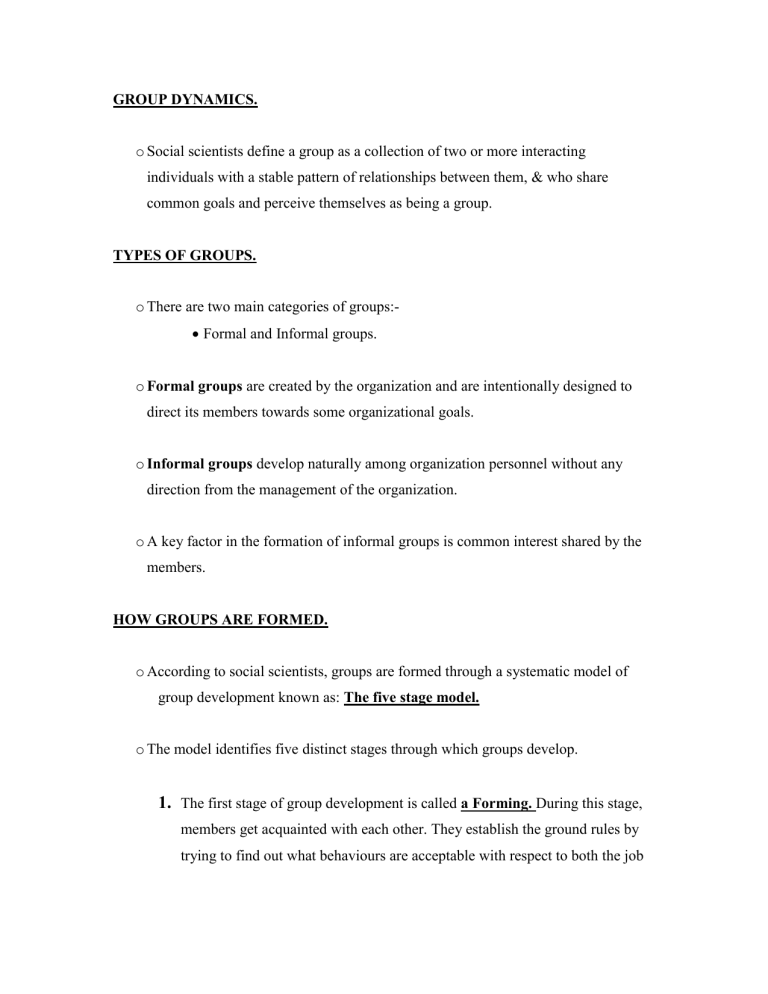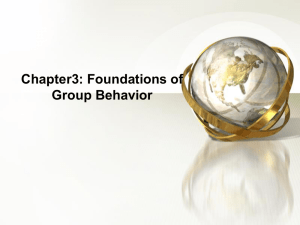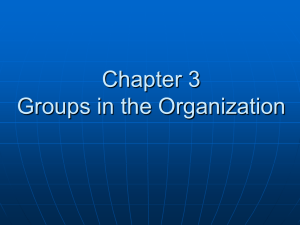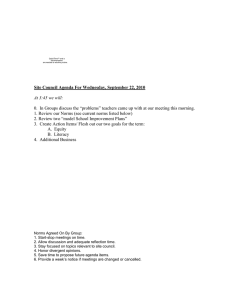
GROUP DYNAMICS. o Social scientists define a group as a collection of two or more interacting individuals with a stable pattern of relationships between them, & who share common goals and perceive themselves as being a group. TYPES OF GROUPS. o There are two main categories of groups: Formal and Informal groups. o Formal groups are created by the organization and are intentionally designed to direct its members towards some organizational goals. o Informal groups develop naturally among organization personnel without any direction from the management of the organization. o A key factor in the formation of informal groups is common interest shared by the members. HOW GROUPS ARE FORMED. o According to social scientists, groups are formed through a systematic model of group development known as: The five stage model. o The model identifies five distinct stages through which groups develop. 1. The first stage of group development is called a Forming. During this stage, members get acquainted with each other. They establish the ground rules by trying to find out what behaviours are acceptable with respect to both the job (how productive are they expected to be?) and interpersonal relationship (who is really in charge?). During the forming stage, people tend to be a bit confused and uncertain about how to act in the group and how beneficial it will be to become a member of the group, when group members start to perceive themselves as being in a group, the forming stage is complete. 2. The second stage of group development is called Storming. This stage is characterized by a high degree of conflict within the group. Members often resist the control of the group’s leader and show hostility towards each other. If these conflicts are not resolved, group members may withdraw and the group will disband. If the conflicts are resolved and the group’s leadership is accepted, the storming stage is completed. 3. The third stage of group development is called Norming. During this stage, the group becomes more cohesive. Identification as group members become greater, close relationship develop and shared feelings become common. Keen interests in finding mutual goals and shared responsibility for the group’s activities are heightened. The norming stage is complete when the members of the group accept a common set of expectations that constitutes an acceptable way of doing things. 4. The fourth stage of group development is called Performing. During this stage, questions about the group’s relationships and leadership have been resolved and the group is ready to work. Having fully developed, the group may now devote its energy to getting the job done. 5. The fifth stage of group development is called Adjourning. This stage recognizes that not all groups last forever. Groups may cease to exist because they have met their goals and are no longer needed. Other groups disintegrate, either because members leave or because the norms that have developed are no longer effective for the group. WHY GROUPS ARE FORMED. 1) People often join groups to satisfy their mutual interest and goals. This is done to the extent that getting together with others allows people to achieve what they cannot achieve alone. Example: - Formation of an organization. 2) Groups are also formed for the purpose of seeking protections from other groups or the security of group membership. Example: - Trade unions are joined to protect workers against abuses by management. Professional associations are formed to protect people in their respective fields against undesirable government regulations and other interferences. 3) Groups also exist because they appeal to basic psychological needs to be social, people are social animals with a basic need to interact with others and groups provide good provide good opportunities for friendships to develop and social needs to be fulfilled. 4) People also join groups because they have a basic desire to have their self-esteem needs fulfilled. Group membership can be a very effective way of nurturing selfesteem. Example:-when a group one belongs to is successful (a sale team). STRUCTURAL DYNAMICS OF WORK GROUPS. o A group structure refers to the inter-relationships between the individuals constituting a group and the characteristics that make group functioning orderly and predictable. o There are four different aspects of group structure:- a) The role of group members. b) The norms or rules and expectations that develop within groups. c) The status (prestige) of group membership. d) The members sense of belonging (cohesiveness). 1) ROLES. o In organization, many roles are assigned by virtue of an individual position within an organization. The person holding the role is known as the role incumbent and the behaviour expected of that person are known as role expectation. o The role incumbent’s recognition of the expectation of his or her role helps avoid social disorganization that would results if clear roles expectations did not exist. o Workers are sometimes confused about the things that are expected of them in the job. This is called role ambiguity and is typically experienced by new members of the organization who have not had a good chance to learn. o As work groups and social groups develop the various group members come to play different roles in the structure. This is known as role differentiation and it is a naturally occurring process. o In organizations, roles tend to be differentiated in some standard ways. Example: - In any group, there tends to be a person who more than anyone else helps the group to reach its goals. This kind of individual is said to play the task-oriented role. o Another person may play the role of making others feel good about themselves. This person is said to play a social-emotional role or a relationsoriented role. o Those who play the role of doing things for themselves at the expense of others are said to play a self-oriented role. 2) NORMS. o Group’s norms are the aspects of a group that enhances their orderly functioning. Norms can be defined as generally agreed upon informal rules that guide group member’s behaviour. They represent shared ways of viewing the world. o Norms though not formal rules, regulate the behavior of groups in important ways. Example: - They foster workers honesty and loyalty to the company, establish appropriate ways to dress etc. o Prescriptive norms dictate behaviours that should be performed while proscriptive norms dictate behaviours that should be avoided. 3) STATUS. o One potential reward of group membership is enjoying the status associated with being in that group. Within the organization status may be recognized as both formal and informal in nature. o Formal status attempts to differentiate between degrees of formal authority given to employees by an organization. This can be by use of status symbols such as job titles or perks such as reserved car packing space. o Status symbols help to remind organization members of their relative roles and this reduces uncertainty and provides stability to the social order (Example: Your small office & desk reminds you of your lower level in the organization.). o They also provide assurance of the various rewards available to those who perform at a superior level. Status symbols also provide a sense of identification by reminding members about the group’s values. o Informal status refers to the prestige accorded to individuals with certain characteristics that are not formally recognized by the organization. Example: Respect for the older and experienced workers, respect for those who posses special skills etc. o Studies on group dynamics have shown that higher status people tend to be more influential than lower status people. 4) COHESIVENESS. o Cohesiveness can be referred to as strength of group members’ desire to remain a part of the group. Highly cohesive work groups are those, in which the members are attracted to one another, accept the group goals and help work towards meeting them. o In very incohesive groups, members dislike one another and may even work at cross purposes. FIVE MAIN FACTORS THAT HELP TO AID GROUPS COHESIVENESSS. 1) The extents of the difficulties people go through inorder to join a group. The greater the difficulties, the more cohesive the group becomes. 2) Group cohesion also tends to be strengthened under conditions of high external threat or competition. When workers face a common enemy, they tend to draw together. 3) The amounts of time group members spend together. The more time spent together, the greater the cohesion. 4) Cohesiveness also tends to be greater in smaller groups than in large groups. 5) Groups with a history of success tend to be more successful, because”Nothing succeeds like success!” and ‘everyone loves a winner’.





